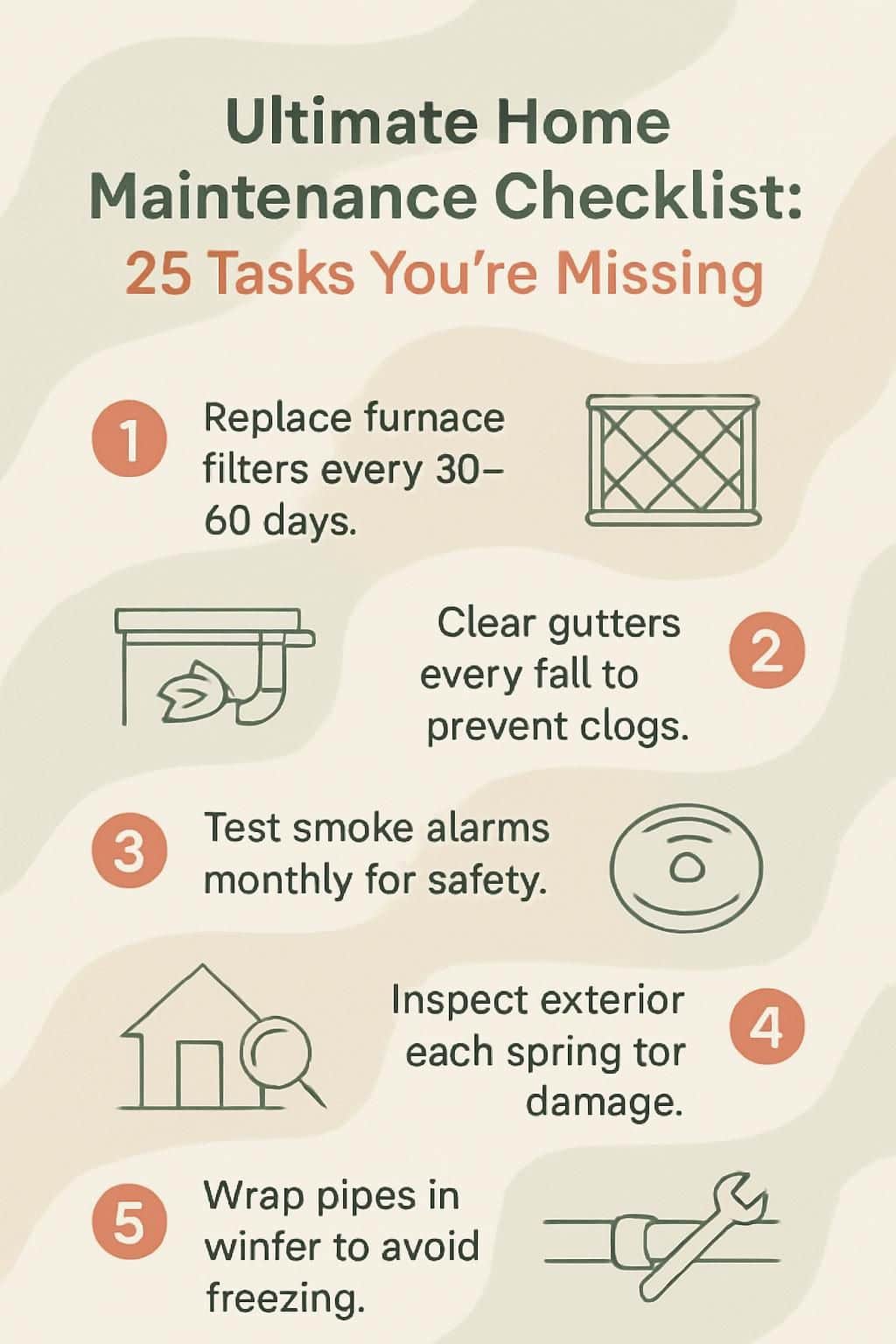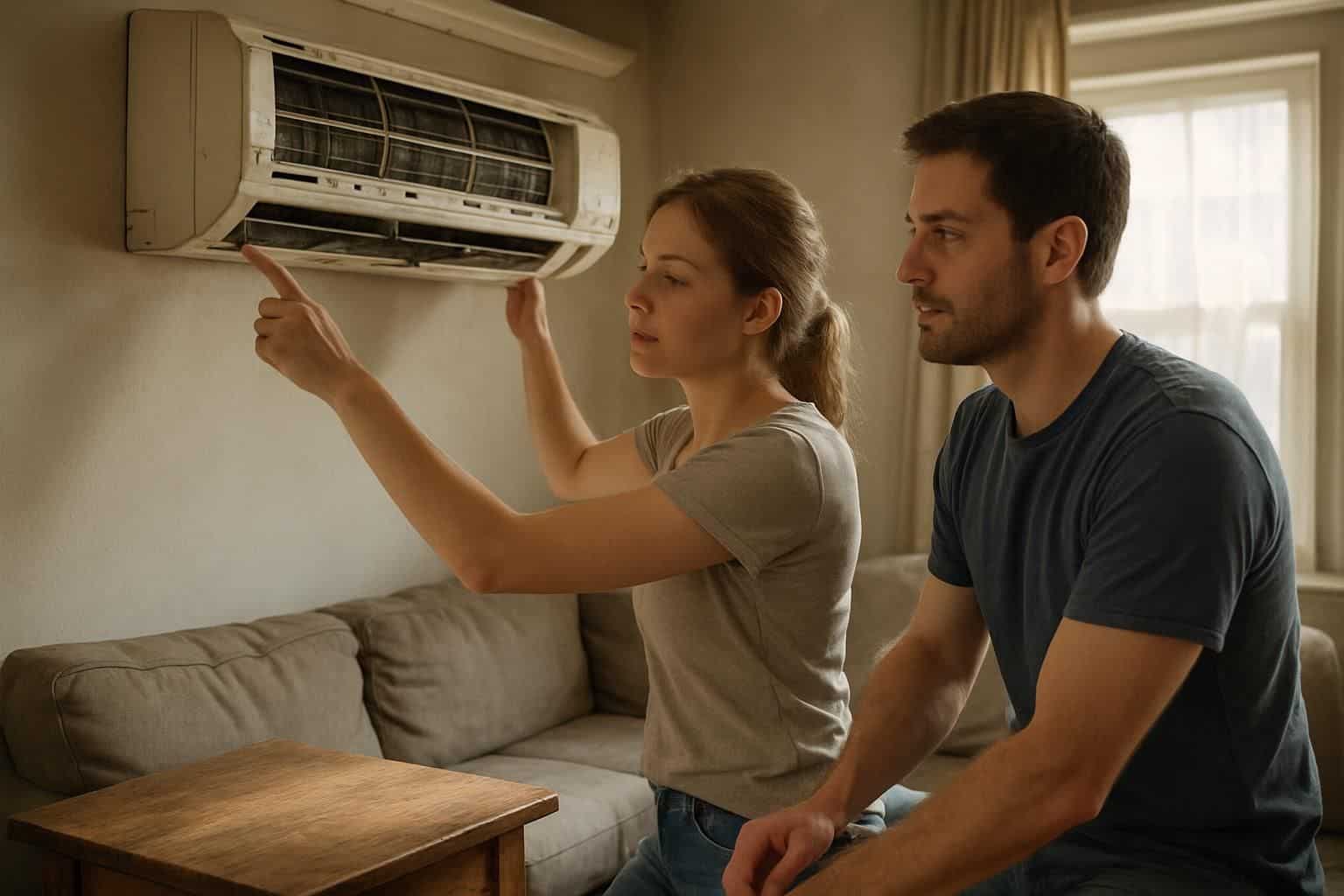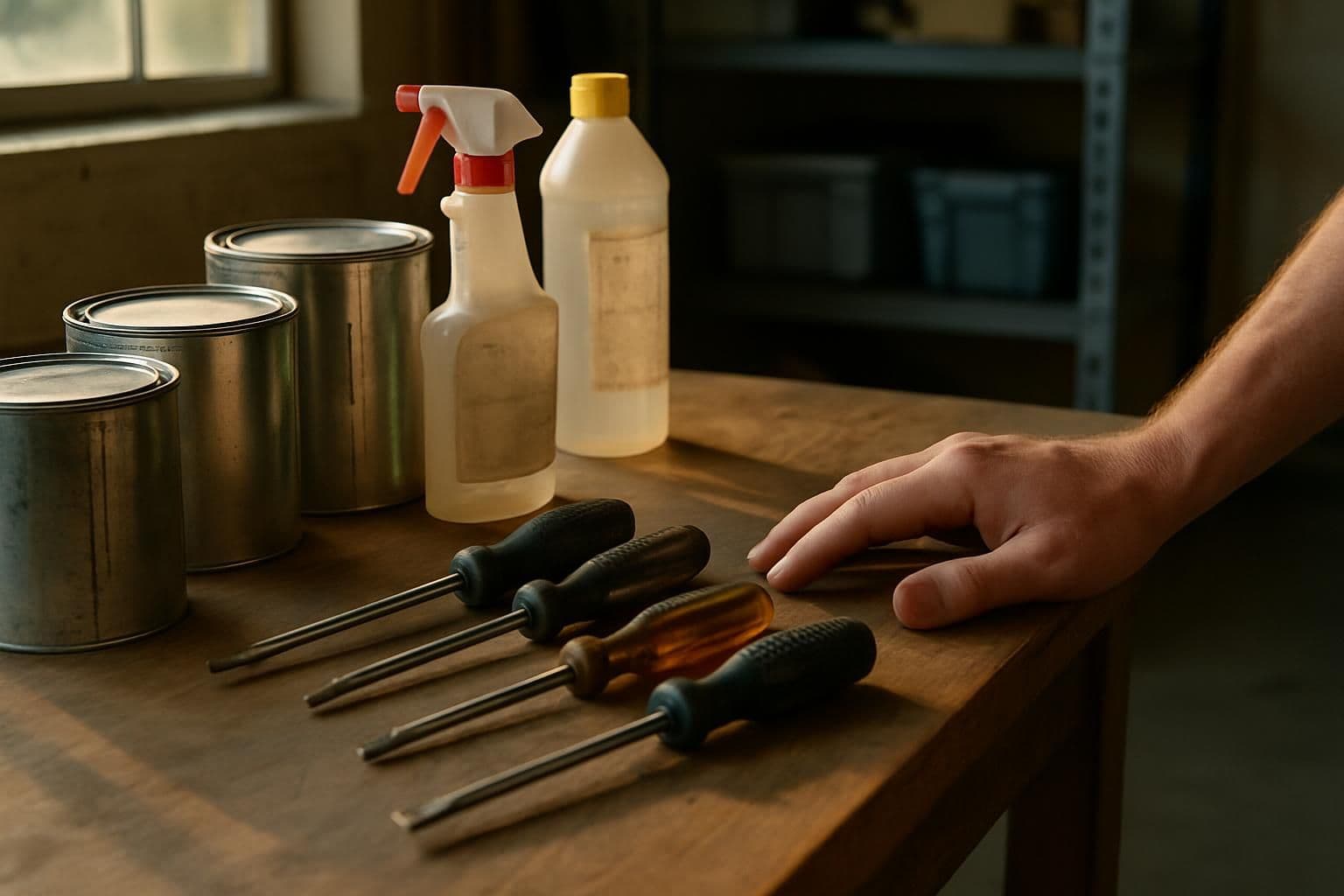Are small home repairs piling up on your to-do list with no end in sight? A recent study states regular upkeep can prevent costly breakdowns and boost a home’s value by thousands each year.
Our ultimate home maintenance checklist simplifies your upkeep tasks, guiding you through exactly what to do every month and season. Your stress-free home care routine starts here!
Key Takeaways
Keeping your home well-maintained each year can add thousands to its value—and help you avoid expensive repairs down the road.
Simple monthly tasks, like replacing furnace filters every 30 to 60 days, boost indoor air quality and keep your HVAC running smoothly.
Seasonal chores are key: clear gutters every fall, wrap pipes in winter, inspect the home’s exterior each spring, and tune sprinklers for summer.
Basic safety checks—testing smoke alarms once a month and checking regularly for plumbing leaks—can head off costly emergencies down the line.
By 2025, smart home gadgets will simplify these tasks even more, alerting you early to small problems before they become serious headaches.
Table of Contents
Monthly Home Maintenance Tasks

Your home needs regular care to stay in top shape. These monthly tasks will keep problems away and save you money on big repairs later.
Clean furnace filters and vents
Dirty furnace filters can restrict airflow, forcing your HVAC system to strain harder than necessary. Typically, filters need changing every 30 to 60 days to maintain fresh indoor air and efficient heating performance.
Filters clogged with dust waste energy, reduce air quality, and cause allergens to spread around your living space. Also, remember to vacuum your heat registers and vents—dust settles easily in these spots and can trigger allergies among family members.

Clean filters protect air quality indoors, keeping your household healthier by reducing dust and pollutants floating around. Replacing them regularly helps your furnace operate smoothly and lets the system last longer without costly repairs.
Just pick up the right-sized filter for your furnace model, shut off your HVAC power, then remove the dirty one and slide the fresh filter into place. It’s easy to mark a reminder on your calendar for the next replacement, so you stay on schedule with this simple home upkeep step.
Test smoke alarms and fire extinguishers
Keeping your furnace filters clean improves air quality—but don’t forget about your home’s safety devices. Smoke alarms watch over your family every night, ready to sound off at any hint of trouble.
Press the test button monthly until the alarm clearly sounds. Many women overlook this easy task, unknowingly risking their family’s safety. Replace alarm batteries the moment they start to weaken, ensuring they’re always ready.
Fire extinguishers also require regular care. Look at the pressure gauge every month, and verify the needle stays in the green area. Smart smoke detectors now offer handy alerts straight to your phone, sending reminders to test and maintain them on schedule.
These quick tasks only take a couple minutes—and they help safeguard your loved ones. Your family counts on reliable safety gear that activates immediately in a crisis. Add these monthly safety checks to your calendar, and commit to keeping your home safe.
Inspect plumbing for leaks
Small plumbing leaks may seem minor, but they can waste gallons of water—and cause expensive damage to your home. Every month, I inspect faucets, toilets, and pipes for even the smallest drips, because tiny leaks often lead to bigger issues.
Use a flashlight to look carefully under sinks, and gently run your hand along the pipes, checking for any damp spots. Water pressure that’s too high may gradually harm your appliances; pressure that’s too low usually means your pipes have a blockage somewhere.
The best defense against water damage is a good offense – regular inspection.
Also, test your sump pump before rainy seasons arrive. I pour a bucket of water right into the sump pit, to double-check the pump activates properly and clears the pit completely. This quick, easy check prevented my basement from flooding twice during heavy storms.
Inspect your water heater regularly too, especially around the base, to detect moisture that may signal the heater is wearing out.
Seasonal Home Maintenance Checklist

Seasons bring unique challenges to your home that need special care. Our seasonal checklist helps you tackle critical tasks before small issues turn into costly repairs.
Fall: Clean gutters and inspect the roof
Fall brings stunning leaves—but for homeowners, it also means clogged gutters and possible roof issues. Clearing your gutters early, before winter sets in, helps stop ice dams and harmful water buildup around your home’s foundation.
Each October, I grab my ladder and some gloves and spend around two hours scooping out pesky leaves, sticks, and debris. Doing this simple chore every autumn saves thousands of dollars in potential repairs later.
Experts at King Roofing suggest inspecting your roof for missing shingles and signs of leaks during gutter cleaning, too.
Your roof needs a careful inspection ahead of harsh winter storms. To start, grab a pair of binoculars, walk around your property, and closely check for loose, cracked, or missing shingles.
Don’t forget to inspect the caulk around flashings for cracks or damage. Also, peek into your attic and look carefully for any water stains or damp patches. Small roof issues quickly turn into expensive repairs if left unchecked—I once missed noticing a tiny leak, and my ceiling started sagging badly after a heavy downpour.
Spending just an hour now to inspect the roof can prevent costly headaches in the future.
Winter: Insulate pipes and prepare snow removal tools
Winter’s bitter cold can seriously damage your home’s plumbing system. Keep pipes safe by wrapping exposed areas with foam insulation sleeves. I learned this the tough way last year—my bathroom pipes froze solid, and repairs cost me a fortune! During spells of extreme cold, let your faucets drip slowly and keep your home heated above 55°F, even if you’re not there.
This quick step could save thousands of dollars in water-damage costs.
It’s also important to prep your snow removal equipment well before winter arrives. Don’t wait until the first storm hits to test your snow blower. Instead, check it early, fill it with fresh fuel, and run it to see if everything works smoothly.
Get plenty of ice melt now—just pick one that’s pet-friendly and gentle on pavement. Keep shovels handy, right by the garage or entrance door, so you’re not scrambling later. Planning ahead now makes life way easier once winter shows its full force.
Spring: Inspect exterior damage and service HVAC systems
Spring is an ideal time to inspect your home’s exterior for winter-related wear and tear. Walk around your property, and check closely for loose siding, cracked paving stones, or roof damage that needs repair.
Your air conditioner also deserves some care, ideally before the hot days set in. Be sure to schedule an HVAC technician to check and service your cooling system—this routine takes about one or two hours.
Timely maintenance helps avoid unexpected summer breakdowns, keeps energy bills lower, and prolongs the equipment’s lifespan.
Give attention to your basement and crawlspace, too, looking carefully for damp spots or leaks caused by spring rains. Clean out your vents and swap old air filters for new ones—this step ensures cleaner indoor air.
It’s also helpful to test your sprinkler system, to check for leaks or faulty sprinkler heads, keeping your lawn green and preventing wasted water. Doing these simple upkeep tasks now sets your home up for smoother maintenance down the road.
Summer: Maintain sprinklers and clean the pool
Summer’s scorching heat calls for smart lawn care and pool upkeep. Each week, I inspect my sprinkler system closely—checking for leaks or damaged heads that could waste valuable water.
The sprinklers run during early mornings to limit evaporation and help the grass absorb moisture efficiently.
For the swimming pool, my routine is straightforward but important: weekly water testing, cleaning skimmer baskets, and brushing pool walls. Last year, I even noticed my kitchen exhaust fan filter had clogged up—it’s easy for these household tasks to sneak up fast!
Also, reversing your ceiling fan direction can boost indoor comfort. Setting ceiling fans correctly pushes cool breezes downward, cutting air conditioning expenses by as much as 15%.
These small, simple efforts keep both your home and yard comfortable during summer heat waves.
Exterior Home Maintenance

Your home’s exterior faces harsh weather every day. A regular check of your roof, gutters, and siding can save you thousands in repair costs.
Roof and gutter inspections
Inspect your roof at least twice a year—once in spring and again in fall—to identify issues early. I ignored a tiny leak one time, thinking it wasn’t serious, and ended up with a hefty repair bill.
So, take the time to check your shingles closely for any signs of wear, cracks, or curling edges. Look carefully for missing shingles, gaps, or warped areas where rain could easily sneak in.
And if climbing up high feels risky or just doesn’t feel right, grab a solid pair of binoculars; you can spot most trouble spots safely from the ground.
Cleaning gutters regularly prevents water from seeping into the foundation and damaging your home. Clear out leaves, twigs, and dirt from both gutters and downspouts, letting rainwater drain properly—away from the structure.
Too many homeowners overlook this chore until they’re faced with overflowing gutters during a storm. If you hate doing this by hand, use a power washer—it saves loads of time—and gutter guards can reduce cleaning by half.
The difference between a small roof repair and a complete replacement often comes down to how quickly you spot the problem.
Landscaping and yard care
Roof care keeps your home dry from above—but your yard needs attention too. Lawns and gardens require regular care to stay healthy, attractive, and functional. Each spring, fertilize your grass and shrubs to encourage healthy growth.
Also, most trees and bushes benefit from seasonal pruning, helping them maintain the right size and attractive shape. Outdoor areas such as decking need yearly refinishing, protecting surfaces from harmful sun rays and rain damage.
Before summer arrives, get your lawnmower serviced—the yearly tune-up keeps it running smoothly all season long. After winter, carefully check your walkways and paving stones; frost and moisture often cause shifting or cracks.
Good yard care does more than just boost curb appeal—it actually increases property value. Smart landscaping choices even cut water costs, especially using plants that do well with less moisture.
Many women set up a simple monthly yard-care schedule, making the chores easier and stress-free.
Interior Home Maintenance

Your home’s inside needs just as much care as the outside. Inside maintenance protects your family and saves money on costly repairs down the road.
Deep clean appliances
Kitchen and laundry appliances need routine deep cleaning to run smoothly and last longer. Appliances like dishwashers, washing machines, and garbage disposals easily trap dirt and grime, causing them to slow down and lose efficiency.
Cleaning your garbage disposal is simple—it takes around 45 minutes, using common items like baking soda, vinegar, and ice cubes to clear buildup and reduce bad odors. Refrigerators, freezers, and clothes dryers also require regular care to avoid future breakdowns and extend their life span.
Major equipment like water heaters and air conditioning units perform better with consistent upkeep. Dirty filters cause furnaces to struggle, wasting energy and driving up your bills.
Most women prefer setting up a regular cleaning schedule, to spot and fix minor issues before they become serious problems. Simple household solutions—like vinegar mixtures for showerheads, or baking soda to neutralize fridge smells—make these tasks easier and quicker to manage.
Check windows and doors for drafts
Drafty windows and doors quietly drain your wallet each month, pushing heating bills higher without you noticing. Last winter, at my own place, the thermostat ran nonstop—but the house stayed chilly.
Air leaks around door frames and window edges create cold areas, forcing your heater into overtime and costing you extra money. Twice per year, do a quick check on window seals and door sweeps for any cracks or gaps.
On a windy day, hold a lit candle near window and door edges…if the flame flickers, air is leaking through. Most fixes—like sealing cracks or gaps—cost very little yet save big bucks on heating.
Proper insulation around doors and windows keeps heat where it belongs and boosts your home’s energy efficiency. Weather stripping naturally wears down, especially around doors—so take time each fall, before winter hits, to inspect and replace it when needed.
Adding new caulking to any small gaps and installing door sweeps stops that chilly air from sneaking inside. Your heating system won’t work as hard, helping it last longer and lowering monthly costs.
Many folks skip these quick checks—but taking just a little extra effort pays off in comfort and savings as seasons change.
Creating a Personalized Maintenance Schedule

A custom home care plan saves you time and money on repairs. Your home needs different care based on its age, location, and the weather in your area.
Weekly, monthly, and annual tasks
Your home needs constant care—regular upkeep saves money and prevents costly repairs later. Follow this simple, personalized guide to maintaining your home:
Weekly Tasks:
- Dust surfaces and vacuum carpets regularly to eliminate allergens and improve indoor air quality.
- Inspect bathroom caulking for mold, as mold thrives quickly in damp places.
Bi-Weekly Tasks:
- Mop hard floors thoroughly to avoid dirt buildup.
- Clean kitchen appliance surfaces regularly to prevent grease accumulation.
- Remember to keep watering your bedroom plants, keeping your sleeping space fresh and healthy.
Monthly Tasks:
- Change furnace filters monthly, keeping your heating and cooling systems efficient.
- Test smoke detectors and carbon monoxide alarms—this quick monthly check can truly save your life.
- Check and maintain the salt levels in your water softener to ensure better water quality.
Quarterly Tasks:
- Clean out dryer vents every three months to decrease the risk of fire and boost dryer efficiency.
- Give appliances such as refrigerators and ovens a deep cleaning to remove hidden grime.
- Check plumbing fixtures regularly—small leaks can quickly escalate into major repairs.
Seasonal Tasks:
- In fall, clean gutters and inspect chimneys ahead of winter storms.
- During winter months, insulate pipes to avoid freezing.
- Spring means servicing your HVAC system and checking the home’s exterior for damage.
- Summer upkeep involves sprinkler maintenance and thorough pool cleaning.
Annual Tasks:
- Arrange a roof inspection by a certified professional yearly to catch issues like cracked or missing shingles early.
- Test all GFCI outlets in kitchens and bathrooms annually to ensure electrical safety.
- Yearly foundation and basement checks help spot cracks and moisture problems early.
Every Two Years:
- Hire a professional to clean your home’s air ducts every two years, helping you breathe fresher indoor air.
- Check the heating element of your water heater bi-annually to boost its efficiency.
- Examine attic insulation every two years, looking for worn areas or gaps.
Every Three Years:
- Schedule a complete inspection from a certified home inspector every three years—it costs roughly $300-500 but can prevent thousands in future repairs.
- Have fireplaces and chimneys professionally cleaned every three years to minimize fire risks.
Every Five Years:
- Refresh your home safety plans and upgrade fire extinguishers every five years.
- Check outdoor walkways and pavers regularly for loose or uneven areas that could cause falls.
- Inspect and service fireplace dampers and flues for proper functioning.
As-Needed Tasks:
- If you see significant leaks in plumbing, immediately call a plumber to fix them quickly.
- Cleaning your fuse box helps prevent flickering lights, so address this promptly if you notice problems.
- Check air vents whenever rooms feel stuffy or show uneven temperatures to clear potential blockages.
How Will Home Maintenance Evolve in 2025?
By 2025, home care tasks will become much quicker and simpler. Most routine jobs will take between 30 minutes and 2 hours—perfect for squeezing into hectic daily schedules. Smart home devices will send alerts for issues like dirty air filters, faulty ductwork, or failing water heaters, letting you tackle problems before they grow costly.
I’ve already seen this firsthand with my new air cleaner—it alerts me right on my phone whenever it needs care.
Outdoor upkeep and insect control will dominate the summer months. Checking sprinkler systems will become routine, taking just an hour or two but noticeably cutting down water bills.
Regular pool care will also become more structured: skimming once each week and scrubbing pool walls every month, keeping algae from taking hold. Simple seasonal checklists like these will extend the lifespan of houses and appliances, especially in brutal winter months when basements and outdoor areas face harsher conditions.
People Also Ask
What home maintenance tasks should I do before winter weather arrives?
Before cold weather settles in, get your chimney inspected and cleaned—a quick step to prevent dangerous chimney fires. Clear leaves and debris from your gutters to avoid ice dams later. Seal leaks around windows and doors to keep your home warm and energy bills low. Lastly, ensure you get your heating system checked by a professional, so the heat stays steady and reliable on chilly winter days.
How often should I clean my dryer vent?
Cleaning your dryer vent once a year helps stop dryer fires and makes the machine dry clothes faster. Regular cleaning also reduces energy costs and keeps the appliance running smoothly. While homeowners often overlook this simple chore, it’s an important part of keeping your home safe.
What are the most important spring home maintenance tasks?
Spring is the right time to inspect your air-conditioning system, making sure it’s ready before summer heat hits. Check your home’s exterior, looking closely for winter damage or leaks that need attention. Test smoke alarms, replacing their batteries if necessary. Also, clear gutters again, as spring storms and debris can clog them, leading to water damage.
Does regular home maintenance affect home loans or insurance?
Regular home upkeep definitely affects loan refinancing and insurance policies. Well-maintained homes usually pass inspections easily, making loan approvals smoother. Insurance companies often offer lower rates for homes that stay in good condition, especially if your safety features stay updated. Preventive care protects your family’s safety—and your home’s market value.
References
https://www.thezebra.com/resources/home/home-maintenance-checklist/ (2024-04-26)
https://www.hsh.com/homeowner/home-maintenance-checklist.html
https://www.amfam.com/resources/articles/at-home/home-maintenance-checklist
https://technologyeducation.org/monthly-home-maintenance-checklist/ (2022-04-18)
https://www.mdsewer.com/plumbing/home-maintenance-checklist
https://www.budgetdumpster.com/blog/fall-home-maintenance-checklist (2023-10-25)
https://wasteremovalusa.com/blog/winter-home-maintenance-checklist/ (2024-12-25)
https://www.stewart.com/en/insights/home-maintenance-checklist-for-winter
https://allbetterapp.com/spring-2025-home-maintenance-checklist/
https://www.amlegendhomes.com/blog/summer-home-maintenance-checklist-preparing-your-home-for-the-season (2024-05-30)
https://www.bhg.com/home-improvement/advice/home-maintenance-checklist/
https://www.carolinarealestatecentral.com/blog/home-maintenance-checklist/
https://homebuyer.com/learn/home-maintenance-checklist (2024-09-17)
https://kelleynan.com/home-maintenance-checklist/ (2023-08-27)
https://www.buzzfeed.com/rossyoder/weekly-home-checklist-home-maintenance-tips (2024-02-22)
https://www.justfix.app/recent-news/home-maintenance-checklist
